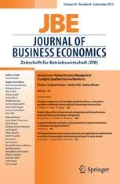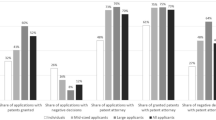Abstract
Prior research shows that family firms differ from non-family firms with regard to intellectual property output. Yet, little is known about how family firms manage their intellectual property. This paper analyses the degree to which patent management in family firms is cross-functional. Patent management is a task that requires coordination across multiple functions in order to be fully effective. We find that in family-owned firms patent management is cross-functional to a higher degree than in non-family-owned firms. Within the group of family-owned firms, we find that family management has a positive impact on the degree to which patent management is cross-functional. We conclude that family firms are not only distinct with regard to intellectual property output but also regarding how they manage their intellectual property.
Similar content being viewed by others
Notes
The same data set has been used by Jell et al. (2013) in a different context. These authors perform an analysis on the patent level, with a focus on the pendency duration of applications.
See http://www.firmendatenbank.de (accessed August 17, 2012).
See http://www.wer-zu-wem.de/ (accessed August 17, 2012).
See https://www.lexisnexis.com/de/business/ (accessed August 17, 2012).
See https://www.ebundesanzeiger.de (accessed August 17, 2012).
See http://www.epo.org/patents/patent-information/raw-data/test/product-14-24.html (accessed August 17, 2012).
For public firms, we use the 30 % voting power threshold, defined by the German Securities Acquisition and Takeover Act (WpÜG §29 Abs. 2).
As robustness checks we changed the thresholds of 50 % (30 %) for private (public) firms. See robustness checks section.
These 44 firms were mostly large multi-division firms such as ABB, Henkel, and BMW.
See http://www.signo-deutschland.de/unternehmen/content/e4154/e4422/index_ger.html (accessed January 5, 2012).
References
Arundel A (2001) The relative effectiveness of patents and secrecy for appropriation. Res Policy 30(4):611–624
Astrachan JH (1988) Family firm and community culture. Fam Bus Rev 1(2):165–189
Astrachan JH, Jaskiewicz P (2008) Emotional returns and emotional costs in privately held family businesses: advancing traditional business valuation. Fam Bus Rev 21(2):139–149
Bertrand M, Schoar A (2006) The role of family in family firms. J Econ Perspect 20(2):73–96
Block J (2010) Family management, family ownership, and downsizing: evidence from S&P 500 firms. Fam Bus Rev 23(2):1–22
Block J (2011) How to pay a non-family manager in a family business: a multi-task principal-agent model. Fam Bus Rev 24(1):9–27
Block J (2012) R&D investments in family and lone founder firms: an agency perspective. J Bus Ventur 27(2):248–265
Block J, Miller D, Jaskiewicz P, Spiegel F (2013) Economic and technological importance of innovations in large family and founder firms: an analysis of patent data. Fam Bus Rev 26(2):180–199
Chen HL, Hsu WT (2009) Family ownership, board independence, and R&D investment. Fam Bus Rev 22:347–362
Chirico F, Salvato C (2008) Knowledge integration and dynamic organizational adaptation in family firms. Fam Bus Rev 21(2):169–181
Chrisman JJ, Patel P (2012) Variations in R&D investments of family and non-family firms: behavioral agency and myopic loss aversion perspectives. Acad Manag J 55(4) (in press)
Chrisman JJ, Chua JH, Kellermanns FW, Chang EPC (2007) Are family managers agents or stewards? An exploratory study in privately held family firms. J Bus Res 60(10):1030–1038
Cohen WM, Nelson RR, Walsh JP (2000) Protecting their intellectual assets: appropriability conditions and why US manufacturing firms patent (or not). NBER working paper no. 7552, February 2000
Combs JG, Penney CR, Crook TR, Short JC (2010) The impact of family representation on CEO compensation. Entrep Theory and Pract 34(6):1125–1144
Corbetta G, Salvato C (2004) Self-serving or self-actualizing? Models of man and agency costs in different types of family firms: a commentary on “Comparing the agency costs of family and non-family firms: conceptual issues and exploratory evidence”. Entrep Theory Pract 28(4):355–362
Davis SM, Lawrence PR (1977) Matrix. Addison–Wesley Pub. Co, Reading
Davis JH, Schoorman FD, Donaldson L (1997) Toward a stewardship theory of management. Acad Manag Rev 22(1):20–47
De Massis A, Frattini F, Lichtenthaler U (2013) Research on technological innovation in family firms: present debates and future directions. Fam Bus Rev 26(1):10–31
Denison DR, Hart SL, Kahn JA (1996) From chimneys to cross-functional teams: developing and validating a diagnostic model. Acad Manag J 39(4):1005–1023
Déniz MCD, Suárez MKC (2005) Corporate social responsibility and family business in Spain. J Bus Ethics 56(1):27–41
Donaldson L, Davis JH (1991) Stewardship theory or agency theory: CEO governance and shareholder returns. Aust J Manag 16(1):49–64
Dyer WG, Whetten DA (2006) Family firms and social responsibility: preliminary evidence from the S&P 500. Entrep Theory Pract 30(6):785–802
Eddleston KA, Kellermanns FW (2007) Destructive and productive family relationships: a stewardship theory perspective. J Bus Ventur 22(4):545–565
Faems D, Van Looy B, Debackere K (2005) Interorganizational collaboration and innovation: toward a portfolio approach. J Prod Innov Manag 22(3):238–250
Flocke H (2008) Das Patentsystem benachteiligt den innovativen Mittelstand. Markt Technik 24:62–63
Ford RC, Randolph WA (1992) Cross-functional structures: a review and integration of matrix organization and project management. J Manag 18(2):267–294
Gambardella A, Harhoff D, Verspagen B (2008) The value of European patents. Eur Manag Rev 5(2):69–84
Giuri P, Mariani M, Brusoni S, Crespi G, Francoz D, Gambardella A, Garcia-Fontes W, Geunac A, Gonzales R, Harhoff D, Hoisl K, Bas CL, Luzzi A, Magazzini L, Nesta L, Nomaler Ö, Palomeras N, Patel P, Romanelli M, Verspagen B (2007) Inventors and invention processes in Europe: results from the PatVal-EU survey. Res Policy 36(8):1107–1127
Gomez-Mejia LR, Haynes KT, Nunez-Nickel M, Jacobson KJL, Moyano-Fuentes J (2007) Socioemotional wealth and business risks in family-controlled firms: evidence from Spanish olive oil mills. Adm Sci Q 52(1):106–137
Granstrand O (1999) The economics and management of intellectual property. Edward Elgar, London
Griffin A, Hauser JR (1996) Integrating R&D and marketing: a review and analysis of the literature. J Prod Innov Manag 13(3):191–215
Holland S, Gaston K, Gomes J (2000) Critical success factors for cross-functional teamwork in new product development. Int J Manag Rev 2(3):231–259
Huang X, Brown A (1999) An analysis and classification of problems in small business. Int Small Bus J 18(1):73–85
Jell F, Henkel J, Hoisl K (2013) The relationship between patenting motives and pendency durations, SSRN Working Paper Series, http://ssrn.com/abstract=2406536
Jerkovsky M (1983) Functional management in matrix organizations. IEEE Trans Eng Manag 30:89–97
Jones GR (1983) Transaction costs, property rights, and organizational culture: an exchange perspective. Adm Sci Q 28(3):454–467
Kahn KB (1996) Interdepartmental integration: a definition with implications for product development performance. J Prod Innov Manag 13(2):137–151
Katz R, Allen TJ (1985) Project performance and the locus of influence in the R&D matrix. Acad Manag J 28(1):67–87
Keller RT (2001) Cross-functional project groups in research and new product development: diversity, communications, job stress, and outcomes. Acad Manag J 44(3):547–555
Kepner E (1983) The family and the firm: a coevolutionary perspective. Org Dyn 12(1):57–70
Ketokivi M, Castañer X (2004) Strategic planning as an integrative device. Adm Sci Q 49(3):337–365
Klein SB, Astrachan JH, Smyrnios KX (2005) The F-PEC scale of family influence: construction, validation, and further implication for theory. Entrep Theory Pract 29(3):321–339
Kolodny HF (1979) Evolution to a matrix organization. Acad Manag Rev 4(4):543–553
Larson EW, Gobeli DH (1987) Matrix management: contradictions and insights. Calif Manag Rev XXIX(4):126–138
Lawson JW (1986) A quick look at matrix organization from the perspective of the practicing manager. Eng Manag Int 4(1):61–70
Le Breton-Miller I, Miller D (2009) Agency vs. stewardship in public family firms: a social embeddedness reconciliation. Entrep Theory Pract 33(6):1169–1191
Lev B (2004) Sharpening the intangibles edge. Harv Bus Rev 82(6):109–116
Levin RC, Klevorick AK, Nelson RR, Winter SG (1987) Appropriating the returns from industrial research and development. Brook Pap Econ Act 3:783–831
McConaughy DL (2000) Family CEOs vs. nonfamily CEOs in the family-controlled firm: an examination of the level and sensitivity of pay to performance. Fam Bus Rev 13(2):121–131
McDonough EF (2000) Investigation of factors contributing to the success of cross-functional teams. J Prod Innov Manag 17(3):221–235
Miller D, Le Breton-Miller I, Scholnick B (2008) Stewardship vs. stagnation: an empirical comparison of small family and non-family businesses. J Manag Stud 45(1):50–78
Munari F, Oriani R, Sobrero M (2010) The effects of owner identity and external governance systems on R&D investments: a study of Western European firms. Res Policy 39(8):1093–1104
Muñoz-Bullón F, Sanchez-Bueno MJ (2011) The impact of family involvement on the R&D intensity of publicly traded firms. Fam Bus Rev 24(1):62–70
Olson EM, Walker OC, Ruekerf RW, Bonnerd JM (2001) Patterns of cooperation during new product development among marketing, operations and R&D: implications for project performance. J Prod Innov Manag 18(4):258–271
Pinto MB, Pinto JK, Prescott JE (1993) Antecedents and consequences of project team cross-functional cooperation. Manag Sci 39(10):1281–1297
Pitkethly RH (2001) Intellectual property strategy in Japanese and UK companies: patent licensing decisions and learning opportunities. Res Policy 30(3):425–442
Randolph WA, Posner BZ (1992) Getting the job done: managing project teams and task forces for success. Prentice Hall, Englewood Cliffs
Reitzig M (2007) How executives can enhance IP strategy and performance. MIT Sloan Manag Rev 49(1):37–43
Reitzig M, Puranam P (2009) Value appropriation as an organizational capability: the case of IP protection through patents. Strateg Manag J 30(7):765–789
Rivette KG, Kline D (2000) Discovering new value in intellectual property. Harv Bus Rev 78(1):54–66
Rowen TD, Howell CD, Gugliotti JA (1980) The pros and cons of matrix management. Adm Manag 41(December):22–24
Sciascia S, Mazzola P (2008) Family involvement in ownership and management: exploring nonlinear effects on performance. Fam Bus Rev 21(4):331–345
Somaya D, Williamson IO, Zhang X (2007) Combining patent law expertise with R&D for patenting performance. Organ Sci 18(6):922–937
Song XM, Parry ME (1992) The R&D-marketing interface in Japanese high-technology firms. J Prod Innov Manag 9(2):91–112
Song XM, Montoya-Weiss MM, Schmidt JB (1997) Antecedents and consequences of cross-functional cooperation: a comparison of R&D, manufacturing, and marketing perspectives. J Prod Innov Manag 14(1):35–47
Taylor C, Silbertson ZA (1973) The economic impact of the patent system: a study of the British experience. Cambridge University Press, Cambridge
Veer T, Jell F (2012) Contributing to Markets for Technology? A comparison of patent filing motives of individual inventors, small companies and universities. Technovation 32(9–10):513–522
Villalonga B, Amit R (2006) How do family ownership, control and management affect firm value? J Financ Econ 80(2):385–417
Wagner S (2007) Make-or-buy decisions in patent related services. Zeitschrift für Betriebswirtschaft Special Issue 4:47–68
Westhead P, Howorth C (2007) Types of private family firms: an exploratory conceptual and empirical analysis. Entrep Reg Dev Int J 19(5):405–431
Zellweger TM, Eddleston KA, Kellermanns FW (2010) Exploring the concept of familiness: introducing family firm identity. J Fam Bus Strategy 1(1):54–63
Zellweger TM, Nason RS, Nordqvist M, Brush CG (2013) Why do family firms strive for nonfinancial goals? An organizational identity perspective. Entrep Theory Pract 37(2):229–248
Author information
Authors and Affiliations
Corresponding author
Rights and permissions
About this article
Cite this article
Jell, F., Block, J.H., Henkel, J. et al. Cross-functional patent management in family firms. J Bus Econ 85, 181–203 (2015). https://doi.org/10.1007/s11573-014-0732-6
Published:
Issue Date:
DOI: https://doi.org/10.1007/s11573-014-0732-6




